Brentwood STW (2020)
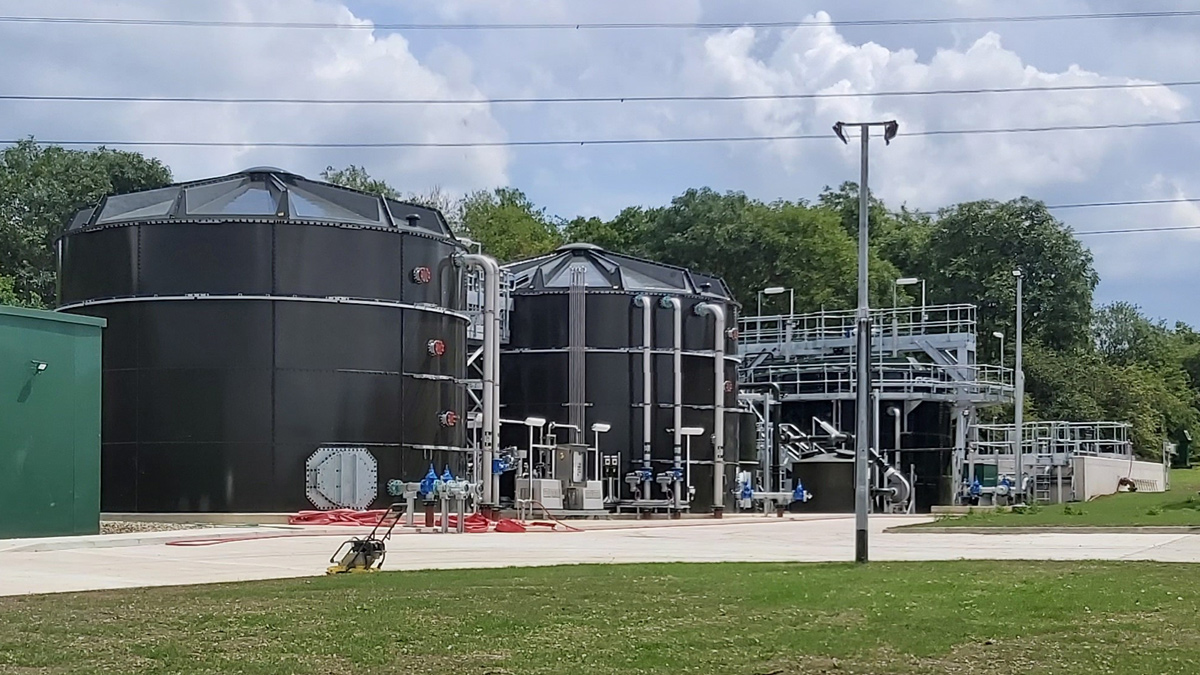
Brentwood STW sludge handling plant - Courtesy of MWH Treatment
Brentwood Sewage Treatment Works (STW) is one of Thames Water’s medium sized treatment works. The site is located to the north-east of London between Harold Wood and Brentwood in Essex. The STW treats foul water from the catchment serving West Brentwood, Warley and Pilgrims Hatch. It currently serves a population of 36,500 which will increase to 41,368 by the year 2026. The works discharges to the River Ingrebourne. SMB, a joint venture between Skanska, MWH Treatment and Balfour Beatty, have undertaken the design, procurement, implementation and commissioning of the works as part of the Thames Water AMP6 eight2O Alliance.
The existing works
Sewage treatment has been undertaken at Brentwood STW since the 1950s. The works has since undergone several expansions and upgrades. The current works includes submersible inlet pumping station, inlet works with escalator screens and flow control/storm separation, pre-precipitation ferric dosing plant for load removal, 1 (No.) balancing tank, 4 (No.) storm tanks, 4 (No.) primary settlement tanks (PSTs), 10 (No.) percolating filters, 3 (No.) humus tanks, 2 (No.) nSAF cells, 2 (No.) Discfilters and a tertiary lagoon. There is a sludge handling plant comprising 1 (No.) picket fence thickener and 2 (No.) sludge holding tanks. Thickened sludge is tankered to a nearby sludge treatment centre for processing.
Drivers for the project
The project driver originally started out as a tightening ammonia consent from 2 mg/l to 1 mg/l (95%ile) as part of the Environment Agency National Environment Programme (NEP5). Once the feasibility stage had commenced on the scheme, Thames Water Asset Management updated the strategic overview of long-term assets and resources (SOLAR) form for the site. This resulted in population equivalent increase, flow to full treatment increase from 192 to 230 litres per second and breach of the existing dry weather flow permit of 7000 m3/d at the 2026 design horizon. A new dry weather permit of 9000 m3/d would be required.
The current consent of 20 (SS), 10 (BOD), 2 (AmmN) was tightened to 20 (SS), 8 (BOD), 1 (AmmN) as a result of load standstill. A site-wide upgrade was required to deal with the above changes to site consent.
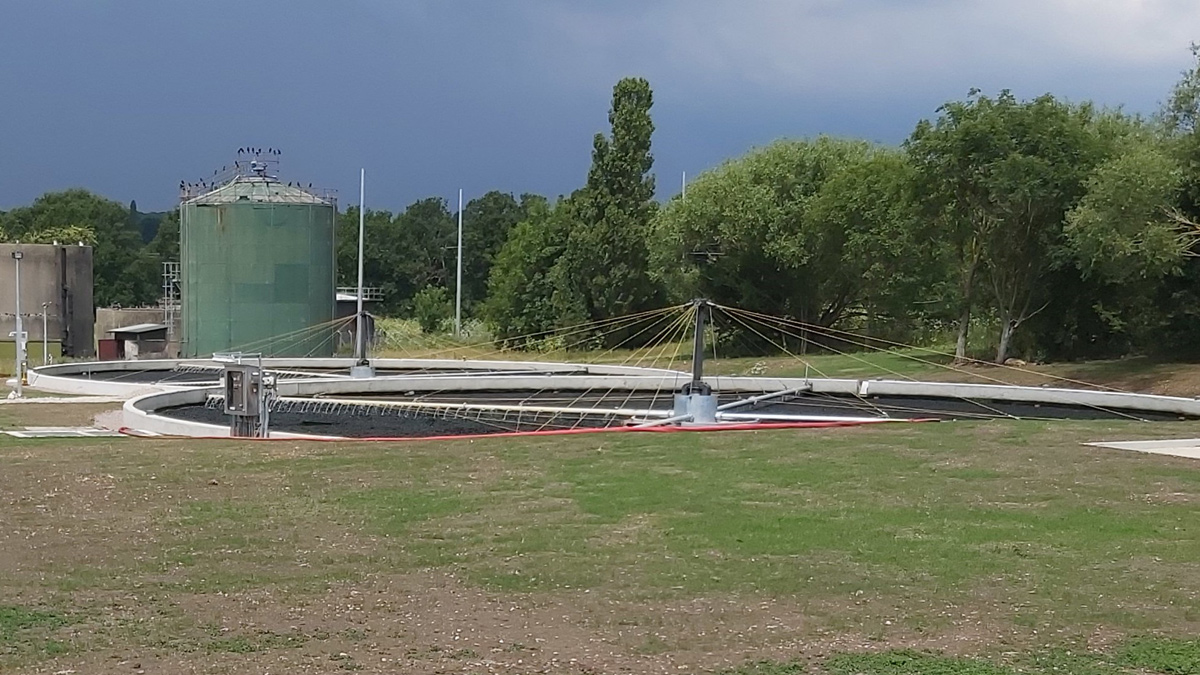
Percolating filters – Courtesy of MWH Treatment
Design
Stantec UK undertook the feasibility and optioneering phase of the scheme to review the upgrade options which included an activated sludge plant, conversion of the site to double filtration with plastic media primary filters and finally expansion of the existing single filtration stream.
Following assessment of the existing assets on site and a whole life cost comparison, the decision was taken collaboratively between SMB and Thames Water to upgrade the existing single filtration stream. Stantec delivered the outline design of the plant, which allowed SMB to engage with the supply chain and gain greater cost certainty for the project.
The scheme was then divided up into multiple work packages which were tendered based on design and build capability in the supply chain. Stantec wrote all the technical specifications, managed the interfaces between the packages and provided technical assurance for third party detailed design following contract award.
Brentwood STW supply chain: Key participants
- Design & delivery contractor: SMB
- Design: Stantec UK (SMB)
- Delivery: MWH Treatment (SMB)
- Primary settlement tank No. 5 scraper: JK Fabrications Ltd
- Percolating filter bases, walls, floor tiles: Joseph Gallagher Ltd
- Percolating filter distributor arms: Tuke and Bell
- Percolating filter media: Day Group
- Humus tank, scraper and recirculation pumping station civil works: Ward & Burke Construction
- Site wide civil work including ducting, MCC bases, underground pipework, percolating filter distribution chamber modifications, humus tank distribution chamber, sludge handling plant bases, roads and drainage: Ward & Burke Construction
- nSAF modifications: De Nora Water Technologies UK
- Tertiary treatment plant: Eliquo Hydrok Ltd
- Picket fence thickener: JK Fabrications Ltd
- Sludge holding tanks, roofs & access stairs: Hayes GFS Ltd
- Sludge holding tank air mixing: Utile Engineering Co
- Odour control unit: Odour Services International Ltd (OSIL)
- MCCs, MCC kiosks and systems integration: Total Automation & Power (TAP)
- Electrical installation and instrumentation: FSD Electrical
- Mechanical installation: DR Clark Services
- Ammonia monitors: Hach Lange
- Technical documentation: 3rd Light Media
New works
The majority of the new assets were constructed offline; the design allowing for minimal interfaces with existing assets.
Primary settlement: The existing balancing tank was converted to a fifth PST to increase hydraulic capacity and primary sludge removal at the front end of the works. The conversion entailed installation of a travelling bridge scraper designed and supplied by JK Fabrications Ltd and new de-sludge pumps connecting into the existing de-sludge rising main which was completed by the mechanical installation subcontractor DR Clark Services.
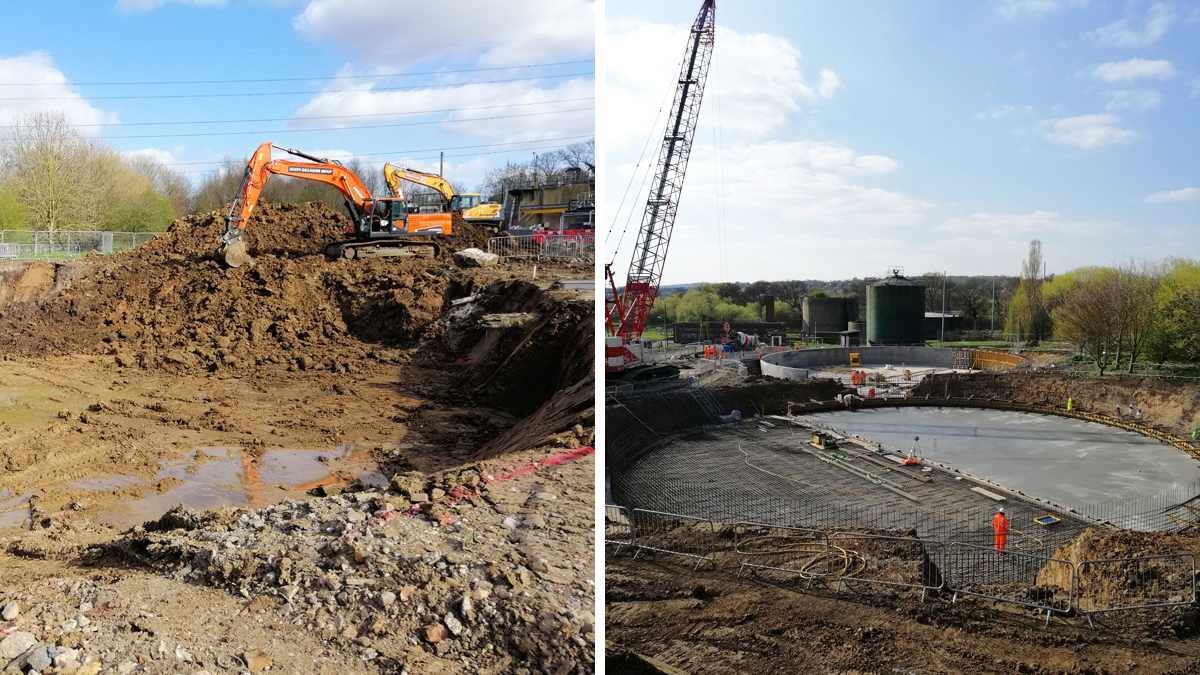
Percolating filter construction – Courtesy of MWH Treatment
Percolating filters: Two additional 32m diameter percolating filters with motorised distributor arms were constructed, designed to run in parallel with the existing filters. The new filters are larger and deeper than the existing filters allowing proportionally higher flow to be passed to them to aid overall biological performance.
Initially it was envisaged that a pumping station would be required to pump flows to the new filters due to the proposed location on site. Through detailed hydraulic assessment it was proven that flow could be gravitated to the new filters, which eliminated the capital and operational cost of the pumping station. The existing complicated flow distribution was assessed and modified to pass flows to the new filters.
The filter base and walls were constructed from in situ concrete due to the fact that they were predominantly buried with the design and construction undertaken by Joseph Gallagher Ltd.
Percolating filter recirculation: The existing recirculation system pumps humus tank effluent back to the PST distribution chamber but was limited on flow capacity. An enhanced system was specified from an early stage to aid biological performance and to reduce the hydraulic loading on the humus tanks.
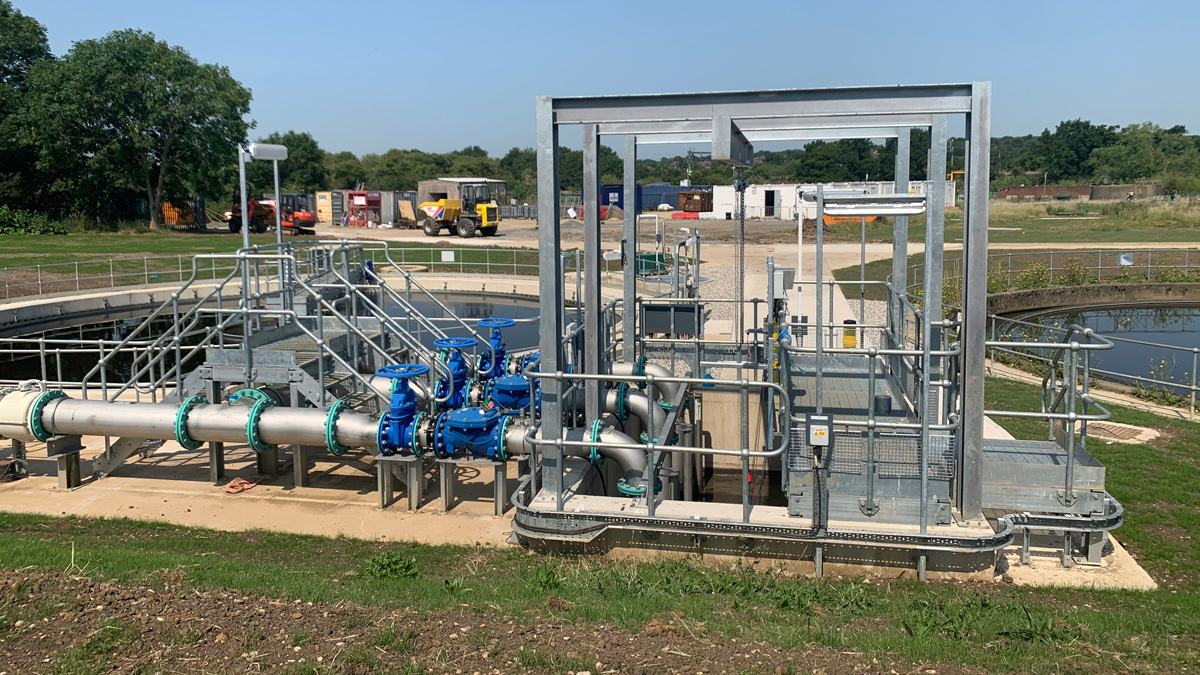
Recirculation pumping station – Courtesy of MWH Treatment
The pumping station was constructed adjacent to the new humus tank and comprises duty/assist/standby pumps capable of providing a filter effluent recirculation flow of up to 155 l/s. The recirculation control system is flow proportional based on the flow to treatment flow meter reading. A new HDPE rising main was laid around the edge of the site discharging into the PST distribution chamber. The civil design and construction was undertaken by Ward & Burke Construction, with mechanical installation undertaken by DR Clark Services.
Humus tank: An additional conical scraped humus tank was provided in parallel to the existing tanks to aid secondary settlement. It was constructed from in situ concrete at a formation level approximately 6.5m below ground level. A new flow distribution chamber was provided to collect the combined filter effluent and pass flow to the new humus tank, the new recirculation pumping station and the existing humus tanks. The distribution chamber provides an even flow split to all four humus tanks, eliminating a historical issue of uneven flow split to the existing tanks. The tank and distribution chamber were designed and constructed by Ward & Burke Construction.
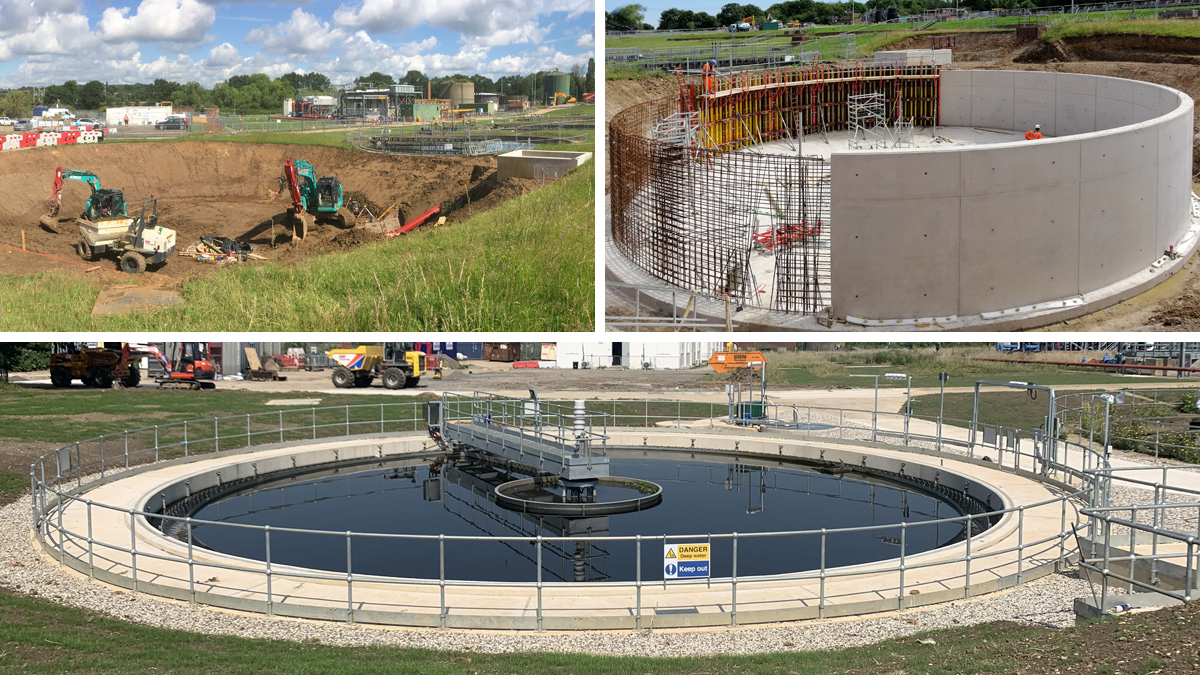
(top) Humus tank under construction and (bottom) completed – Courtesy of MWH Treatment
nSAF: A dual cell nitrifying submerged aerated filter (nSAF) plant was built in 2009 to provide additional biological treatment to follow the percolating filters. The existing plant provided a platform for improvements to be made to enhance the treatment further under this scheme at a low capital investment. An optimisation of the existing process was developed through early supplier engagement and comprised topping up the media in the existing cells along with the development and implementation of an improved control system for the plant.
Flow and ammonia monitors were installed upstream and downstream of the nSAF plant, along with actuated feed and air valves, making it possible to automatically cycle cells in and out of service based on the real-time effluent conditions. This process enables the nSAFs to run at higher biological loading rates at lower flows, making it much more responsive to rapid increases in feed flow and load; a historical shortfall of this technology. The ammonia monitors also give a useful indication of the ammonia levels in the effluent prior to the tertiary solids removal stage to allow operator intervention if required. The nSAF modifications and control system were provide by De Nora Water Technologies UK. The ammonia monitors were by Hach Lange.
Tertiary treatment plant: The existing Discfilter plant was installed alongside the nSAF plant in 2009. The plant would not reliably meet the new BOD consent without extensive modification or the addition of chemical dosing.
A new Mecana plant was specified to meet the new consent comprising 2 (No.) SF21/105 units alongside 2 (No.) flocculation tanks to mitigate the risk of future consent tightening. The flocculation tanks were reused from an early AMP6 low P trial at Cirencester STW. Effluent flows to the Mecana plant by gravity from the existing nSAF plant before passing to the outfall. Backwash flows gravitate to the existing site return liquor pumping station.
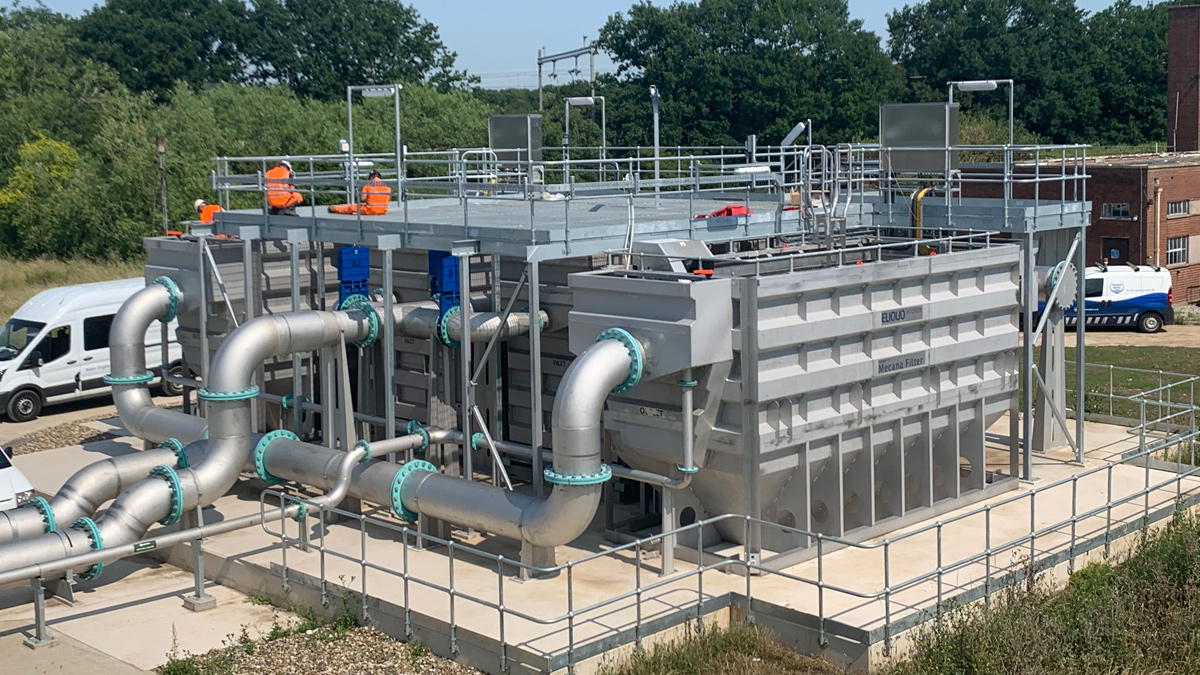
Tertiary treatment plant, 2 (No.) flocculation tanks inside, 2 (No.) SF21/105 Mecana units outside – Courtesy of MWH Treatment
The effluent quality from the Mecana plant has enabled the existing Discfilters and tertiary lagoons to be isolated from use completely, and the Discfilters are likely to be redeployed at another Thames Water site.
The tertiary treatment plant and interconnecting pipework between tanks was designed and installed by Eliquo Hydrok Ltd. The stainless steel feed and discharge pipework to the plant was undertaken by DR Clark Services.
Sludge handling
The existing sludge handling facility at Brentwood comprises 1 (No.) picket fence thickener (PFT) and 2 (No.) sludge holding tanks (SHTs). There is no redundancy in the system should there be an issue with the thickener and there is insufficient storage to manage the sludge tankering adequately. With the projected growth and associated increased sludge production, an upgrade to the system was required.
A new sludge transfer pumping station was constructed to receive the primary sludge from the 5 (No.) PSTs and evenly distribute it to the existing and new PFTs. An additional PFT was provided to allow robust and reliable sludge thickening. The plant was designed and constructed by JK Fabrications Ltd.
Two new sludge holding tanks from Hayes GFS Ltd (total capacity 524m3) were installed downstream of the new PFT taking the total sludge holding volume of the site to 8.5 days at the 2026 design horizon. The glass-coated steel tanks each have a roof, air mixing system (from Utile Engineering) and access stairs. The pipework and control system allow for both new and existing PFTs to discharge to the new SHTs with an automatic actuated valve changeover.
The new sludge transfer pumping station, PFT and SHTs covers are all ducted to a new odour control unit (OCU) to mitigate the odour impact. The OCU, designed and installed by Odour Services International Ltd (OSIL), has a primary biofilter followed by a secondary carbon polishing unit.
A new access road with drainage and turning facility was constructed to serve the new sludge handling assets. All civil works in the sludge handling area by Ward and Burke Construction.
Power distribution and control
The existing power distribution system comprised an incoming motor control centre (MCC) which managed mains/generator changeover and distributed power to various MCCs around site dedicated to process units. There was insufficient spare capacity on the existing panels to feed the significant amount of new equipment being installed. A new main incoming switchboard/MCC was installed to manage the mains/generator changeover, feed all new and existing equipment and provide spare capacity for future upgrades. A second MCC was installed to supply and control the sludge handling plant.
A new fibre optic ring main around the whole site was installed to allow fast communication between all new and equipment programmable logic controllers (PLCs) and the SCADA system on site.
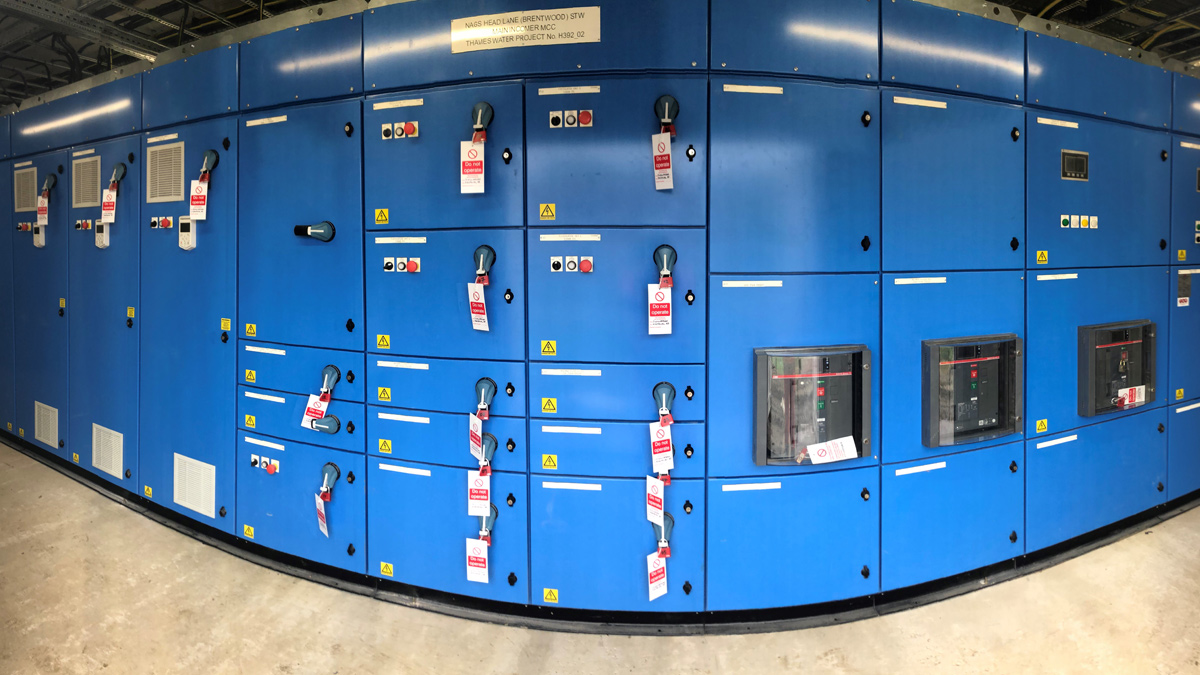
Main incomer MCC/switchboard – Courtesy of MWH Treatment
Conclusion
At the time of writing (June 2020) all civil, mechanical, electrical and ICA aspects of the work are complete. The regulatory output date for meeting the revised discharge permit of March 2020 was achieved following successful commissioning of the new percolating filters, recirculation system, humus tank, nSAF and tertiary treatment plant. The remaining elements associated with growth (PST5, PFT and SHTs) are well advanced with wet commissioning due to start imminently. By autumn 2020, the site will be handed over to Thames Water Operations.
There is a strong possibility that Brentwood STW will receive a first-time phosphorus consent in the AMP7 WINEP programme, the works delivered in AMP6 (sludge plant and Mecana facility including the flocculation tanks) will minimise the necessary works to achieve the P consent.
The delivery model for the scheme as a whole has worked well with SMB completing the feasibility and outline design and utilising supply chain capability to carry out the detailed design and build, managing interfaces where necessary and enabling the necessary collaboration between suppliers.
From the beginning of the scheme a strong working relationship was formed with the Thames Water Operations team, which has resulted in key decisions being discussed and agreed quickly with the right level of input from the end user to avoid issues at the end of the project. The process solution has comfortably met and even exceeded the expectations against model predictions which has resulted in a reliable, robust treatment process.












